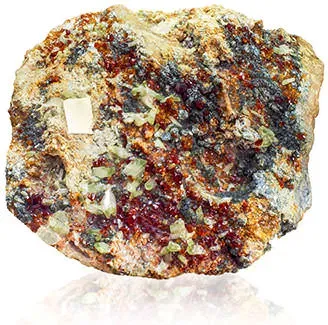 Hessonite is a calcium aluminum silicate. It is an orangish brown version of grossular
Hessonite is a calcium aluminum silicate. It is an orangish brown version of grossular ![]() garnet that is also known as 'cinnamon stone' because of its color. Tsavorite is the name of the other variety of grossular garnet, which is green. The name hessonite comes from the ancient Greek word esson, meaning inferior, because of the stone's low density and hardness, compared to other kinds of garnet. Hessonite has been prized for thousands of years. The ancient Greeks and Romans used the stone in jewelry, and for cameo and intaglio pieces.
garnet that is also known as 'cinnamon stone' because of its color. Tsavorite is the name of the other variety of grossular garnet, which is green. The name hessonite comes from the ancient Greek word esson, meaning inferior, because of the stone's low density and hardness, compared to other kinds of garnet. Hessonite has been prized for thousands of years. The ancient Greeks and Romans used the stone in jewelry, and for cameo and intaglio pieces.
 Hessonite has been confused with hyacinth, the orange variety of zircon. However, hessonite can be distinguished by its density, which is much lower than zircon's. The beautiful orange color of hessonite comes from the presence of iron and manganese within the stone. It can also range in color from yellow-brown to honey yellow and sometimes even pinkish. Hessonite tends to have a lot of swirls of inclusions, which gives the stone a honey-like appearance. Hessonite rates a 6.5 to 7 on the hardness scale. It has a nice vitreous to greasy luster, no cleavage, and is transparent to translucent. It is normally given mixed, oval, or round cuts.
Hessonite has been confused with hyacinth, the orange variety of zircon. However, hessonite can be distinguished by its density, which is much lower than zircon's. The beautiful orange color of hessonite comes from the presence of iron and manganese within the stone. It can also range in color from yellow-brown to honey yellow and sometimes even pinkish. Hessonite tends to have a lot of swirls of inclusions, which gives the stone a honey-like appearance. Hessonite rates a 6.5 to 7 on the hardness scale. It has a nice vitreous to greasy luster, no cleavage, and is transparent to translucent. It is normally given mixed, oval, or round cuts.
 Hessonite is found in metamorphic rocks or in gem gravels and sand. Major sources for the stone include Asbestos, Quebec, in Canada; St. Barbora Adit, Bohemia, in the Czech Republic; Bavaria, Germany; Valle d'Aosta, in northwest Italy; Chelyabinsk Oblast, Urals, in central Russia; Zermatt in the Alpine canton of Valais, in southern Switzerland; Okkampitiya, in southeast Sri Lanka, and various locations around Siberia and Brazil. In the United States, hessonite can be found in Maine, New Hampshire, California, Connecticut and Massachusetts.
Hessonite is found in metamorphic rocks or in gem gravels and sand. Major sources for the stone include Asbestos, Quebec, in Canada; St. Barbora Adit, Bohemia, in the Czech Republic; Bavaria, Germany; Valle d'Aosta, in northwest Italy; Chelyabinsk Oblast, Urals, in central Russia; Zermatt in the Alpine canton of Valais, in southern Switzerland; Okkampitiya, in southeast Sri Lanka, and various locations around Siberia and Brazil. In the United States, hessonite can be found in Maine, New Hampshire, California, Connecticut and Massachusetts.
 Hessonite is a stone that can help the wearer recognize and appreciate his virtues, bringing about a great confidence. When the stone is set in gold, it is said to be a powerful talisman, increasing happiness and lifespan. In Hindu, hessonite is known as 'gomedha.' Gomedha is said to have been formed from the fingernails of the great demon, Vala. Vala was a very powerful demon who caused trouble for all the other gods in the universe. When Vala was finally captured and killed by the other gods, his body was cut into pieces, and different parts of his limbs were transformed into precious gems. Vala's fingernails turned into hessonite, and were scattered all over the lakes of the East.
Hessonite is a stone that can help the wearer recognize and appreciate his virtues, bringing about a great confidence. When the stone is set in gold, it is said to be a powerful talisman, increasing happiness and lifespan. In Hindu, hessonite is known as 'gomedha.' Gomedha is said to have been formed from the fingernails of the great demon, Vala. Vala was a very powerful demon who caused trouble for all the other gods in the universe. When Vala was finally captured and killed by the other gods, his body was cut into pieces, and different parts of his limbs were transformed into precious gems. Vala's fingernails turned into hessonite, and were scattered all over the lakes of the East.